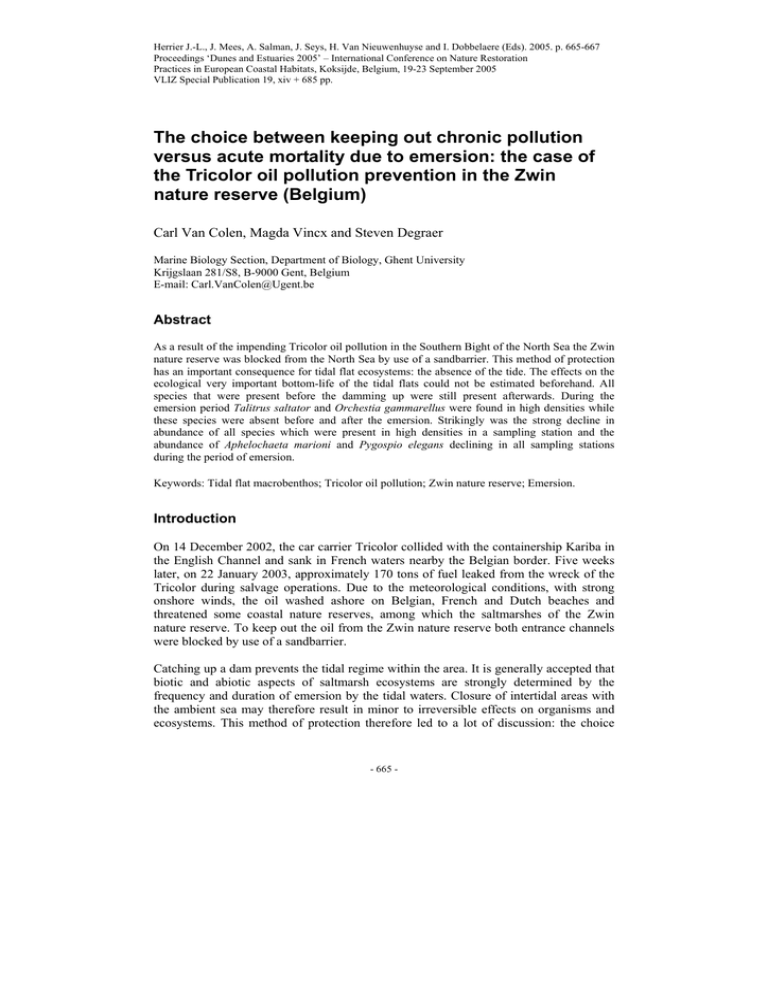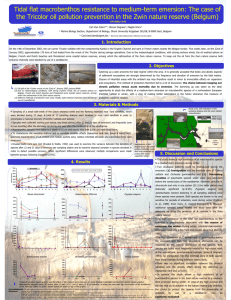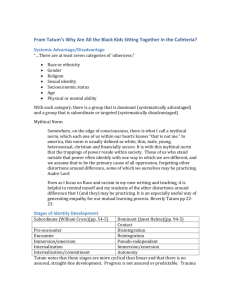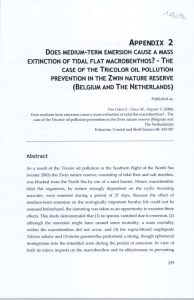Document 12056979
advertisement

Herrier J.-L., J. Mees, A. Salman, J. Seys, H. Van Nieuwenhuyse and I. Dobbelaere (Eds). 2005. p. 665-667 Proceedings ‘Dunes and Estuaries 2005’ – International Conference on Nature Restoration Practices in European Coastal Habitats, Koksijde, Belgium, 19-23 September 2005 VLIZ Special Publication 19, xiv + 685 pp. The choice between keeping out chronic pollution versus acute mortality due to emersion: the case of the Tricolor oil pollution prevention in the Zwin nature reserve (Belgium) Carl Van Colen, Magda Vincx and Steven Degraer Marine Biology Section, Department of Biology, Ghent University Krijgslaan 281/S8, B-9000 Gent, Belgium E-mail: Carl.VanColen@Ugent.be Abstract As a result of the impending Tricolor oil pollution in the Southern Bight of the North Sea the Zwin nature reserve was blocked from the North Sea by use of a sandbarrier. This method of protection has an important consequence for tidal flat ecosystems: the absence of the tide. The effects on the ecological very important bottom-life of the tidal flats could not be estimated beforehand. All species that were present before the damming up were still present afterwards. During the emersion period Talitrus saltator and Orchestia gammarellus were found in high densities while these species were absent before and after the emersion. Strikingly was the strong decline in abundance of all species which were present in high densities in a sampling station and the abundance of Aphelochaeta marioni and Pygospio elegans declining in all sampling stations during the period of emersion. Keywords: Tidal flat macrobenthos; Tricolor oil pollution; Zwin nature reserve; Emersion. Introduction On 14 December 2002, the car carrier Tricolor collided with the containership Kariba in the English Channel and sank in French waters nearby the Belgian border. Five weeks later, on 22 January 2003, approximately 170 tons of fuel leaked from the wreck of the Tricolor during salvage operations. Due to the meteorological conditions, with strong onshore winds, the oil washed ashore on Belgian, French and Dutch beaches and threatened some coastal nature reserves, among which the saltmarshes of the Zwin nature reserve. To keep out the oil from the Zwin nature reserve both entrance channels were blocked by use of a sandbarrier. Catching up a dam prevents the tidal regime within the area. It is generally accepted that biotic and abiotic aspects of saltmarsh ecosystems are strongly determined by the frequency and duration of emersion by the tidal waters. Closure of intertidal areas with the ambient sea may therefore result in minor to irreversible effects on organisms and ecosystems. This method of protection therefore led to a lot of discussion: the choice - 665 - C. Van Colen et al. between keeping out chronic pollution versus acute mortality due to emersion. The damming up was taken as the ideal opportunity to study the effects of a medium-term emersion on macrobenthic species of a northwestern European intertidal habitat in winter, with a view of making better estimations in the future whenever this measure of protection could be needed. Materials and methods To study the effects of a medium-term emersion on macrobenthic species, samples (macrobenthos and physical variables) were collected starting just before, during and frequently after (to study recovery) the damming up. Sampling stations were localized at specific places in order to encompass a maximal diversity of benthic habitats and species. Results and discussion This study shows a high resistance of all macrobenthic species to a medium-term emersion during winter. Two ecological patterns could be distinguished during the emersion: 1) immigration into the intertidal zone of Talitrus saltator and Orchestia gammarellus, and 2) decreasing densities of polychaete species which were very abundant before the construction of the sandbarrier. However both patterns were not significant. Pygospio elegans and Aphelochaeta marioni declining in all sampling stations where these species were present. Both species are known to be very sensitive for periods of emersion, even during winter (Fortuyn et al., 1989). The high resistance of the tidal flat macrobenthos to the emersion is presumptively associated with the season of emersion: the winter. During winter, intertidal macrobenthic organisms need only a few food and oxygen. The high abundance of T. saltator and O. gammarellus during the emersion and their low abundance afterwards can be explained by the natural distribution of these species. Both species are found most frequently nearby the high-water mark at the supralittoral, semi-terrestrial habitats (Jones and Wigham, 1993). Immigration into the intertidal zone of both species from these habitats during emersion seems likely. Because no strong effects were detected as a consequence of the medium-term emersion, we can properly not consider any recovery. For that reason, density changes after the removal of the sandbarrier are believed to be due to natural temporal variation. Conclusion In view of the high survival of the macrobenthos to a medium-term emersion and the fact that oil pollution in the nature reserve was inhibited, the choice to protect the reserve from the impending oil pollution by use of a sandbarrier may be positively evaluated. - 666 - The Tricolor oil pollution prevention in the Zwin nature reserve (Belgium) Acknowledgements The authors want to thank the people of the Marine Biology Section who assisted during the fieldwork and in analysing the macrobenthic and sedimentological samples. We also want to thank Kris Struyf for the logistic support of this study. References Fortuin A.W., A. Meijboom and L. de Wolf. 1989. Het gebruik van de stormvloedkering bij de afbouwwerkzaamheden in de Oosterschelde: effecten van een aantal sluitingsscenario’s op bodemdieren. Rapporten en Verslagen 1989(2):79. Jones M.B. and G.D. Wigham. 1993. Reproductive-biology of Orchestia-gammarellus (Crustacea, Amphipoda) living in a sewage-treatment works. Journal of the Marine Biological Association of the United Kingdom 73(2):405-416. - 667 -








